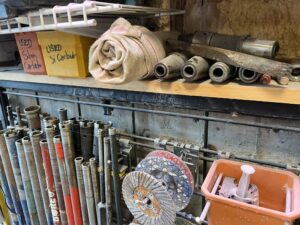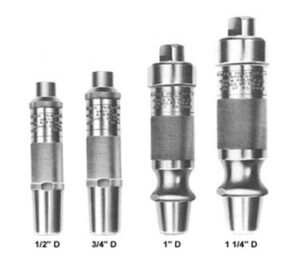
Home » Carve » Tools » Power Carving Tools » Oil That Hammer
My first “power tool” for sculpting was an angle grinder fitted up with a masonry grinding disc. It seemed an amazing step from the serenity of hand tools to the dust and noise of machinery, and yet the allure of power had touched me.
At a Camp Brotherhood Symposium workshop, I learned about fret cutting and bought a turbo diamond blade that still seems so indispensable for roughing out forms. I also watched the figurative carvers dance their carbide chisels in and out of tight spaces on voluptuous marble forms.
In another arena, granite gods and goddesses with bushing tools were contouring, texturing and anointing salt and pepper obelisks and spires. Maybe it was the beauty of the sculpture, or perhaps the romantic notion of historic production (air hammers have been around for over a century) that coaxed me over to the demo booth. I nervously plugged a pneumatic hammer into the air hose and attacked a piece of white marble with a 3/4 inch, 3 tooth chisel. Plug in your earplugs, suck the straps down on the goggles and snap some new filters into the respirator; I am hooked! Of course I bought one – a big one. And yes, quite a few chisels too.
I went back to the studio and hammered ‘till the compressor wheezed and my wrists felt like soba noodles. I later wimped back and told my woeful tales of pogo-sticking around my stone pile trying to hang onto this piston powered pugilator. It was graciously swapped for a smaller piston size hammer. I went back to the studio wiser, safer, happier, and supposedly more controlled. That was several years ago, and I’ve since bought another big hammer, several smaller ones, lots more chisels, some anti-vibration gloves, and a bigger compressor.
Pneumatic hammers are as versatile as the chisels you fit into them: points, rondels, tooths, flats, capes, drills, rippers, and bushing tools. The traditional hardened steel chisels work well on softer stone and some prefer them for fine detailing. Carbide tipped chisels bite into harder marble and granite and do so with less frequent sharpening. Remember, never quench carbide tools when sharpening. Cooling tungsten carbide rapidly can cause cracking and failure. Keep carbide chisels in a tool roll or other means of isolation. Bouncing around a toolbox, carbide against carbide can chip a fine edge or tooth. You really don’t want to grab a less than perfect tool when your muse has pushed into another reality and finally you’re finding the edge of perfect form within that block of Statuario.
Air hammer maintenance is pretty simple. Give it clean, dry air, at the recommended pressure from an adequate supply. Keep the water trap, filter, regulator and hoses in good condition. Put a couple drops of 10W pneumatic oil into the air inlet before and after the day’s use. Not much to go wrong. Stay away from additives that might build up deposits inside the tool. At the very least, put a couple drops in at the end of the day to preclude rusting. Recent conversations with several tool manufacturers confirm sales person chatter; lack of oil is the main cause of failure. It seems that most stoneworkers do not want stains on their products and are very conscientious about keeping oil away from the jobsite, including their pneumatic tools. Pneumatic hammers have tight tolerances so air drives the piston consistently and smoothly. Normally, light (10W) spindle oil provides enough cling to seal the piston but not constrain operation. Dirt or contaminants from a decomposing air hose can create a sticky sludge that makes the tool erratic. An overnight soak in kerosene will generally flush this gunk out. Dry the tool out, put in a few drops of oil and it should once again light up your ears with that familiar drone. I think it akin to the sound of a bagpipe; a continual presence behind a sparkling melody consistent with stone and purpose. Oh, chase away those dour spirits from the studio. Oil your hammer and let it play its tune!



We need some kind of descriptive text here.